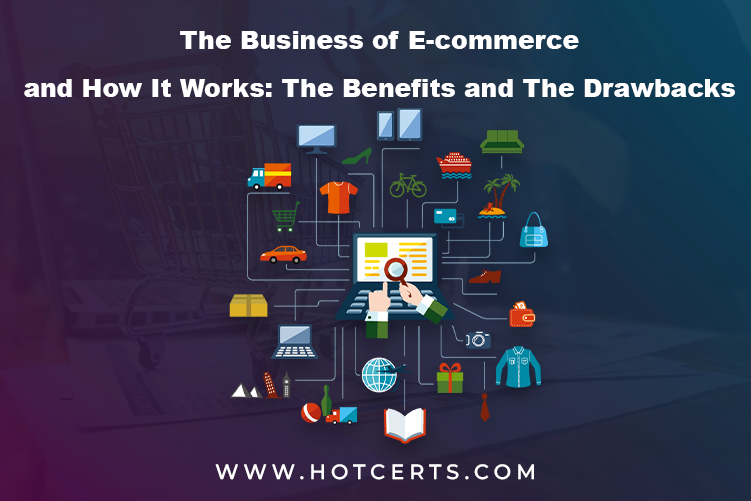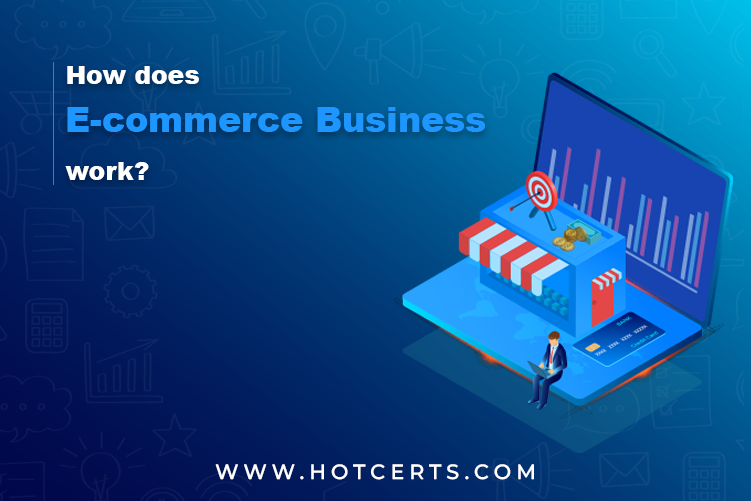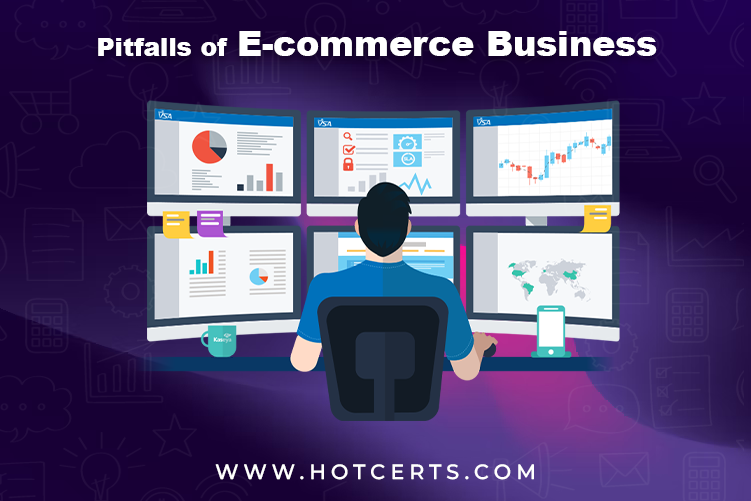The E-commerce Business and How It Works: Explain its Benefits and The Drawbacks:
During COVID-19, many physical businesses have faced a significant loss in selling their products. People were not permitted to step out of their houses during the lockdown. Every physical company in the world faces complexities in selling its product. Many employers had to fire their workers because they could not pay them their salaries due to the significant loss.
About every people faced problems during this pandemic. However, during this pandemic, a business made a huge impact and changed the world’s perception of traditional shopping. The business is named an “E-commerce” business.
It has entirely changed the traditional shopping where you don’t have to haste physically to the store and risk your life during the pandemic. You only need a smartphone with a stable internet connection, and you can receive your desired product right at your door. Isn’t it marvelous? You can buy almost every product over the internet, such as groceries, to any electric device.
E-commerce has made a massive impact on every business during COVID-19. Before the pandemic, people were unaware of E-commerce and how it could effortlessly solve their problems. E-commerce has made a great profit and surged because people could not buy their stuff physically.
E-commerce has provided many entrepreneurs to develop and raise their business over E-commerce websites or platforms. It has also given the best relaxation to the buyers because they only require a smartphone with a stable internet connection, and boom, they can buy any product but sit at their house.
According to research, in 2020, when it was COVID-19, E-commerce sales reached a record $861.14 billion only in the US.
We’ll now discuss what an E-commerce business is and how it functions. Also, we’ll discuss some significant advantages and pitfalls of E-commerce. Keep reading the article to know in deep about E-commerce.
What is an E-commerce Business?
E-commerce (sometimes referred to as electronic commerce) is a business model of selling and buying products and services over an electronic network or internet (online). It empowers many individuals to sell or purchase goods and services online. The ‘E’ in “E-commerce” represents an ‘e’ in “email.” The E-commerce business has undoubtedly been present over many past years, but, at that period, people were not aware of its worth and importance.
However, in COVID-19, people understood how vibrant E-commerce shopping was for them because they could not go out during lockdown to buy the kinds of stuff. The same happened to the sellers because they could not get orders for their products physically during the pandemic.
But now, they only need to install an E-commerce app or run their websites on any browser and order anything they wish to buy. After 1-3 days, you will receive your product right at your doorstep. The same case is with E-commerce entrepreneurs. When the buyer orders any product from their website, they only need to pack the product safely and ship it to its customer’s provided location.
According to the latest research, E-commerce businesses like Amazon, Shopify, eBay, Daraz, and many more platforms have gained more than 150% profit during COVID-19 compared to before the pandemic. You all must be aware that Amazon CEO “Jeff Bezos” has become the world’s richest man during this COVID-19.
In this new age of technologies, almost every good and service is available through E-commerce transactions. From books, music, medical services, plane or train tickets, groceries, financial services, online banking, and even a needle, we can eventually buy or utilize anything from this online platform by sitting at your home or watching TV.
How does E-commerce Business work?
An E-commerce business works on the same principles and models as a physical business. Buyers visit your E-commerce store or website, browse their required products and order it from your E-commerce store. The main difference is that they don’t need to physically rush to shopping malls with a couch and fill it with products, or you are not bound to any limited area or region. You can even purchase from another country by only sitting on your sofa.
Here is the process flow of how an E-commerce business works:
Receiving the Orders: The very step is where buyers place their desired orders through an E-commerce website or online portal. The website owner or entrepreneur then notes it through the order receiving module.
Accepting the Orders: After receiving the order, the seller notes it. The seller makes sure that all the information is correct. After confirming the report, the seller accepts the order and moves to the next step.
Processing the Orders: The next step after accepting the order is to process the payment, log the sales, and mark the order as complete. The payment methods are two types; the customer has two options while placing the order. The first option is that the customer can pay all the amount through a credit card or debit card when processing. The second type is called “COD” or “Cash On Delivery,” where customers have to pay all the amount when they receive their product.
Shipping the Order: The last step in the E-commerce business process is shipping the product. Sellers have to make sure of prompt delivery. They must ensure that the product is well-packed and sent to the given address. The customer then receives the product.
To better understand the E-commerce business flow, here are the detailed process steps from which E-commerce revolves around:
First, buyer visits your E-commerce shop or website, search or browser your products, and select the desired outcome. Then the buyer chooses the product’s size and color or design and adds it to the cart.
- The seller or order management software confirms whether the product is available in stock or not.
- If the demanded product is in stock and the buyer is ready to check out, he enters his credit card details or selects the COD (Cash On Delivery) option on the payment page.
- The payment processer then confirms if the customer has enough cash in a credit card or bank to proceed with the transaction.
- If the customer has enough cash, he gets a message on the E-commerce website that the transaction is successful. These types of processes happen in a few seconds.
- After the successful payment transaction, the buyer receives a message on the website or application that the order has been successfully processed.
- Then the merchant or seller dispatch the order from the warehouse and ships it to the customer’s given address. The buyer then receives the email that the order is sent from the warehouse. The customer has the service of tracking the order anytime.
- After dispatching, the order is delivered, and the transaction is complete.
- The customer then has the option to review the product on the website, which can be helpful for other customers and the sellers.
- All the above steps are virtual, not physical, only the computer or web server will do all the steps, and the customer receives the order only.
What are the Different Types of E-commerce?
There are different types of E-commerce businesses that you can opt for according to your business model, capital investment, and preferences. Other companies have different techniques and strategies. Some of the most used types of E-commerce business are:
- B2B – Business to Business
- B2C – Business to Consumers
- C2B – Consumer to Business
- Affiliate Marketing
- Google AdWords Marketing
- Online Auction Selling
- Website Marketing
- Social Media Marketing
Benefits of E-commerce Business
There are numerous advantages of E-commerce now. One of the most notable advantages of E-commerce is that you don’t have to rush physically to the store with couch and hassle to find the product. You only have to place the order by using your smartphone and wait for it to be delivered to your door. To understand how E-commerce business benefits, here are the advantages of an E-commerce business:
A powerful B2B (Business to Business) web-based business is a phase of computerized experience that enables your association to effectively meet market and client needs by opening new deals channels and constantly reaching new market segments. Allows Empower for growth and scale.
You can convey esteem and immediately answer changes on the lookout by making and testing convincing substances for your designated B2B purchasers. Additionally, by taking on extensible B2B online business cloud arrangements, you can redo your current innovation and fundamentally work on your showcasing and merchandising capacities.
Particularly for the financial specialists who do “outsource,” the strategies, when smoothed out, permit these organizations to answer the market and the patterns of E-commerce and buyers’ requests energetically.
You will receive a faster response as compared to the physical business. For instance, you go to a shopping mall and see a long line of customers at the cash counter. You have to wait a long to wait for your turn. Instead, you can get a faster response from an E-commerce business. You only have to visit the website and get your order delivered to your doorstep without hesitation.
- E-commerce business has terminated the geographical or region barrier. Both buyers and sellers can commune with each other from any globe.
- Internet business is the 24*7 accessible shops. For example, the site is accessible whenever for shopping.
- Internet business gives quick conveyance absent a lot of exertion from the client. All the client objections and criticism is tended to, which saves time for both client and the organization.
- Online business furnishes vendors with a worldwide reach. They eliminate the obstructions (geology) of the spot. Venders and purchasers can now meet in a virtual world without confining their area, empowering direct contact.
- Online business gives speedier trading strategies as the items are only a couple of snaps away and are accessible to be perused 24//7. It wipes out a significant number of the reasonable expenses related to running an actual store permitting organizations to get a lot higher pace of return.
- It gives quick conveyance of products to clients with minimal exertion. Client protests are additionally managed rapidly as they are on the web. It likewise saves time, energy, and bother for the two buyers and organizations.
Another enormous benefit is the comfort it offers. Clients can shop 24 hours every day as the site is accessible for perusing day in and day out.
Pitfalls of E-commerce Business
Despite having so many advantages, E-commerce businesses have some significant pitfalls also that should get resolved in the future. Here are some pitfalls of using an E-commerce business:
- The beginning-up cost of internet business is high. The price includes the equipment and programming arrangement and the preparation cost of the representatives.
- Not all sites are adequate. Accordingly, the gamble of disappointment is extremely high. There are a few web-based business sites, yet a few out of every odd place became effective.
- Because of association in the web-based medium, miscommunication between clients and companies happens. Any correspondence hole prompts client disappointment.
- Security is an essential worry in online business. A client makes an installment utilizing net banking or credit or check cards.
- Notwithstanding, there are grumblings about private data like bank subtleties getting spilled, and wrongfully cash being charged from the record.
- Likewise, there are occurrences when the shipments are lost or some unacceptable request is conveyed. It brings the client a sensation of disappointment and outrage.
- The underlying Launching cost of an internet business entry is exceptionally high because of all the specialized equipment, programming arrangement, worker preparation expenses, and customary support and care costs a fortune.
- The E-Commerce industry is at a high gamble of disappointment, and we have watched many organizations riding the flood of websites during the 2000s have hopelessly fizzled. That chance is similarly as high today.
- Security can be precarious concerning online business. Stories we hear pretty often when there are numerous security breaks where client data is taken. Visa theft, separate data stealing, and so on are as yet central issues for clients.
Then, there is the issue of satisfaction. Indeed, even in the wake of requesting, inconveniences like transportation, conveyance, and missteps might happen. It makes the organization disappointed with clients as they either return the item or get it traded. On the off chance that some significant issue occurs, customers might record an objection against the organization.
Conclusion
The E-commerce business has one of the biggest markets globally. If you also want to scale your business, and E-commerce platform is the best way to gain massive profit. However, it has many difficulties while starting over this platform. Physical business is still the best way for your startup.
Many entrepreneurs have still failed to start their business on the E-commerce platform. Whether you’re doing B2B or B2C marketing, you still want better luck competing with already present competitors. Comment below if you’re going to get started with an E-commerce platform and get senior advice from Hotcerts’ team.




